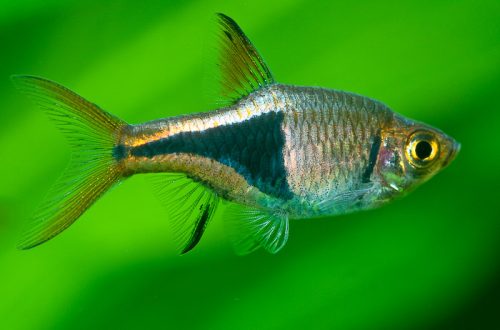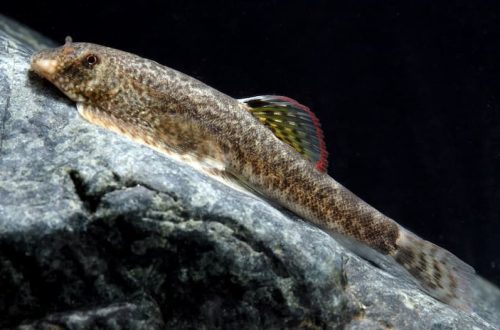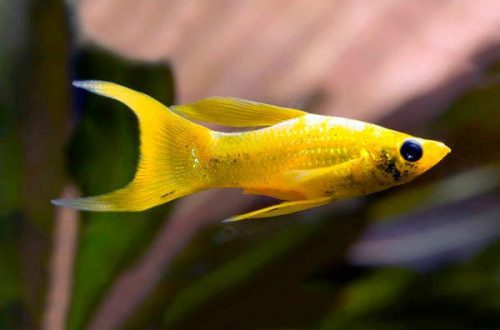
Barbus Reval
Barbus Reval, scientific name Pethia reval, belongs to the Cyprinidae family. This fish has long been considered a color variety of Barbus Cuminga and was singled out as an independent species only in 2008, therefore, despite its relatively young history, it has been found in aquarists for a long time. Easy to keep and breed, compatible with many other peaceful species, can be recommended to beginner aquarists.

Contents
Habitat
Endemic to the island of Sri Lanka, located off the coast of India. Inhabits shallow water bodies and tributaries of larger rivers in the western part of the island. In the rivers flowing into the Bay of Bengal (northeast end), hybrids are already found, resulting from crossing with related species, which, apparently, were released into the wild from home aquaria.
Brief information:
- The volume of the aquarium – from 60 liters.
- Temperature – 18-26°C
- Value pH — 6.0–7.5
- Water hardness – soft (2-12 dGH)
- Substrate type – any
- Lighting – subdued
- Brackish water – no
- Water movement – light or moderate
- The size of the fish is about 3 cm.
- Feeding – any food of suitable size
- Temperament – peaceful
- Keeping in a group of 6-10 individuals
Description
Adult individuals reach a length of about 3 cm. Outwardly, they resemble the already mentioned Cuming Barbus, they have a silvery-yellow color and black marks located behind the gill cover and at the base of the tail. The differences are in the color of the dorsal and ventral fins, in Barbus Rewal they are red. Sexual dimorphism is weakly expressed. Males are somewhat smaller and more colorful than females.
Food
Accepts most popular foods, these are dry flakes, granules, live or frozen bloodworms, brine shrimp, etc. In a home aquarium, it can be quite content with exclusively dry foods.
Maintenance and care, arrangement of the aquarium
The optimal size of the aquarium for a small flock of these fish starts from 60 liters. The choice of decoration is not critical, the main thing is to provide enough space for swimming, so aquatic plants should not be allowed to grow excessively if they are used. Some sources note that dark soil and subdued light have a positive effect on the color of fish, making it brighter.
Successful keeping largely depends on maintaining stable water conditions in the aquarium within the recommended range of hydrochemical values. Mandatory care procedures are: weekly replacement of part of the water with fresh water, regular cleaning of the soil and decor elements from organic waste (excrement, food debris, etc.), equipment prevention and monitoring of key indicators (pH, dGH, concentration of nitrogen compounds, etc. d.).
Behavior and Compatibility
Active schooling fish, compatible with many other species of comparable size. It should be borne in mind that the high mobility of Reval Barbs may be excessive for some slow-moving fish from among the Golden, Labyrinth, Killy fish.
Breeding / breeding
Breeding is quite simple. Under favorable conditions, spawning occurs regularly, however, the survival rate of fry in the general aquarium will be extremely low. They will fall prey to adult fish and will lack suitable food. Parental instincts are not developed, so the parents themselves, on occasion, are not averse to feasting on their own offspring.
In order to preserve juveniles, a separate spawning aquarium is used, which is equipped with a simple airlift filter with a sponge and a heater. A separate lighting system is not required, the light coming from the room will be enough. Artificial plants or unpretentious shade-loving mosses and ferns are used as design elements.
With the onset of the mating season, the fish scatter their eggs in the water column. Since the incubation period lasts only 24-36 hours, it is necessary to carefully transfer it to a separate tank until it is eaten or fry appear. In a spawning aquarium, the fry will be safe, the only problem will be the purchase of special food, such as powdered products or Artemia nauuplius.
Fish diseases
In a balanced aquarium ecosystem with species-specific conditions, diseases rarely occur. Diseases are caused by environmental degradation, contact with sick fish, and injuries. If this could not be avoided, then more about the symptoms and methods of treatment in the section “Diseases of aquarium fish”.





